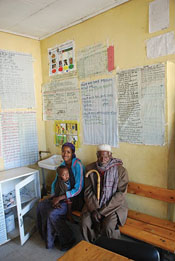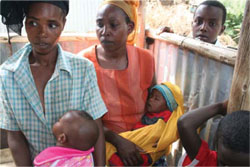Using community survey data to improve immunization coverage
After analysing the survey data collected in the kebele, and from the nearest health centre and the woreda Health Office, one of the things that Alemitu was able to establish was the immunization status of the children who were under the age of one year. She needed to know this in order to plan her immunization programmes. And, of course, therefore she also needed to know what the actual numbers were.
Look back at Figure 16.3. How many children were aged under one year in the 'real life' kebele pictured in that poster? What percentage of the total population were under one year?
There were 88 children aged under one year, representing 3.3% of the total population of 2,667 individuals.
Alemitu's kebele contained 5,456 individuals. If 3.3% of community members are aged under one year, how many would you expect to find in Alemitu's kebele?
Three point three per cent (3.3) of 5,456 is 3.3 x 5,456 ÷ 100 = 180. So you would expect to find around 180 infants under one year in a kebele of 5,456 people.
When Alemitu analysed the results of her community survey, she found that the immunization coverage of the kebele was below the national target; only 84% of the infants were fully immunized by the age of 12 months. This immediately alerted her to the need to improve the immunization coverage rates, so she began to think of ways that she could do this. One strategy was to put a chart on the wall of the Health Post to show parents how many children were not fully immunized, in order to encourage them to bring their children for vaccination (Figure 16.5). She also made plans for community conversations about the importance of immunization and asked her supervisor about increasing the number of outreach immunization visits. Notice here that Alemitu was moving forward on more than one front.
Fully immunized infants in Ethiopia have received all scheduled doses of BCG, pentavalent, oral polio and measles vaccines. In the near future, they will also receive rotavirus and pneumococcal vaccines (see the Immunization Module).

Immunization coverage is just one example of how a careful analysis of community survey data can indicate which aspects of the community health service are already doing well, and which need to be improved. After discussion with the kebele leaders and other opinion leaders in the community, Alemitu decided that the immunization problem that was most important to tackle first was the low uptake of measles vaccine. This was leading to high levels of preventable measles among children in the community. However, in order to do something about this, Alemitu needed to recognise that people had different views on the vaccine. Although some of these views might not be supported by evidence, nevertheless people would be committed to them and she needed to respect them. She also needed to acknowledge that, as with all medical treatment, things can occasionally go wrong. So you can see that there is an ethical aspect to this.
Can you think of any ethical issues that might arise during an immunization campaign?
There were several ethical issues that Alemitu had to be aware of. For example, each person has to give their informed consent to every intervention that is carried out on them or their children. This includes immunization (Figure 16.6). So Alemitu needed to ensure truthfulness in her work so that everyone knew the positive benefits of immunization, but also the small risk of an adverse reaction and what to do if it occurs.

Each person or parent has the autonomy to decide whether to accept immunization – Alemitu could not force parents to accept the measles vaccine for their children, but she had a responsibility to give them clear information to help them make a decision.